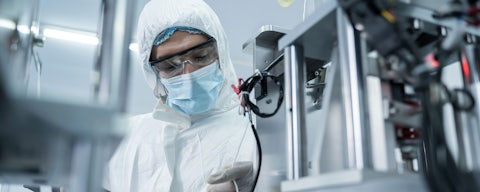- Case study
A model for employee safety and economic security
How a global medical device company is building resilience with predictive insights

Who we worked with
A leading global medical device manufacturer
How we helped
We developed epidemiological models with high predictive accuracy for insight-driven decision-making
What the company needed
To predict where employees would be at risk from COVID-19 and understand the impact on plant operations, sales, and the bottom line
What the company got
Predictions that were 90–95% accurate to protect individual employees and business operations
Challenge
Keeping employees safe and business moving
As the threat from COVID-19 became a reality, a leading global manufacturer of medical devices – including ventilators – took swift action to prevent employees from getting sick and manage the production of its life-saving devices.
Existing analytical models – the prediction curves we see from government-funded healthcare agencies and academic institutions – were not making forecasts at a local level – by county or zip code, for example. The manufacturer needed that depth of granularity to identify who in its plants were most at risk and how to protect them. Similarly, it was vital that the company understood the impact on demand and supply for its devices and the impact on the overall supply chain to make the right decisions about its plants' operations.
Solution
Predicting and preparing for peaks
Genpact built epidemiological models to provide weekly forecasts of when COVID-19 cases would peak for the company's locations around the world. The model also helped business functions understand the impact of Coronavirus on its employees, overall plant operations, supply chain, sales, and the bottom line.
Our rapid analytics response pods created the solution. Analytics teams with multidisciplinary skills – data engineering, data visualization, data science, business analysis, and industry expertise – worked on a hyper-agile delivery model with 24–48-hour sprint cycles.
Inputs for the prediction model included population density, dates when restrictions began, the mobility of people in the area, lifestyle factors such as socioeconomic status, education, and access to healthcare, and the manufacturer's own data on employees' symptoms and past medical history. This allowed us to pinpoint the most at-risk people, so the manufacturer could adapt working conditions and provide advice and support.
Working with the chief analytics officer, chief medical officer, epidemiologists, and senior data scientists, we refresh the models weekly. By sharing the insights with global operational risk officer, chief plant officers, and heads of HR and supply chain, the models help the company determine:
- Whether a plant should remain open
- When and how production would be impacted
- If specific roles or number of people should stay at home
- How to best modify shift times and patterns
The models also help with demand sensing. Though the need for ventilators skyrocketed, the demand for devices used in elective surgeries dropped. We are now combining external data on COVID-19 with internal data, like historical sales and revenue trends, inventory levels, manufacturing capacity, and orders, and applying data science and modeling to perform sales and operational planning.
Insights from the analytics help the company determine:
- Surges in elective surgeries
- The level of demand
- How plant operations and sales teams should respond to the ramp-up
- How to phase employees in back safely
Impact
Safe employees and a resilient business
Speed, agility, and flexibility were key. Our team gleaned impressive insights in just two weeks with 90–95% accuracy to guide decisions that protect high-risk employees, keep operations running, and help the business prepare for the future.
And our models performed better than existing approaches. The chief medical officer said, "Your model has proven to be accurate, perhaps even more than local government projections."
With greater foresight as to when and how to get ready for the return to elective surgery and the ramp-up in orders, the manufacturer is building resilience for the long term. It can meet future demand for devices and prepare its sales teams to go back into the field with a solid view of sales forecasts.
Though the pandemic may have put great pressure on the company, thanks to a valuable analytics partnership, it's emerging stronger with accurate predictive modeling, enabling it to make the right strategy decisions.